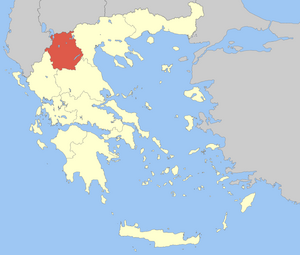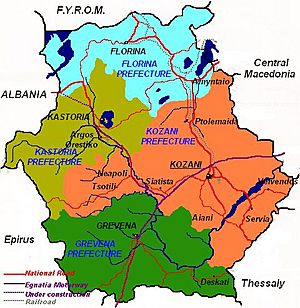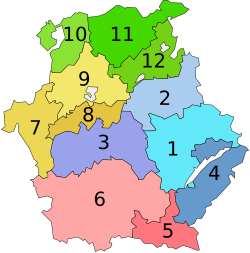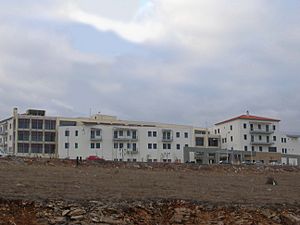Western Macedonia facts for kids
Quick facts for kids
Western Macedonia
Δυτική Μακεδονία
|
|
|---|---|
|
Administrative region of Greece
|
|
 |
|
| Country | |
| Region | Macedonia |
| Decentralized Administration | Epirus and Western Macedonia |
| Capital | Kozani |
| Regional units |
List
Florina
Grevena Kastoria Kozani |
| Area | |
| • Total | 9,451 km2 (3,649 sq mi) |
| Population
(2021)
|
|
| • Total | 255,056 |
| • Density | 26.9872/km2 (69.897/sq mi) |
| Demonym(s) | Macedonian |
| Time zone | UTC+2 (EET) |
| • Summer (DST) | UTC+3 (EEST) |
| ISO 3166 code | GR-C |
| HDI (2019) | 0.880 very high · 2nd of 13 |
Western Macedonia (which is Ditikí Makedonía in Greek) is one of the thirteen main regions of Greece. It makes up the western part of a larger area called Macedonia.
This region is located in northwest Greece. It shares borders with Central Macedonia to the east, Thessaly to the south, and Epirus to the west. To the north, it meets the countries of Republic of North Macedonia and Albania.
Western Macedonia is divided into four smaller areas called regional units. These are Florina, Grevena, Kastoria, and Kozani. In 2021, about 255,000 people lived here.
Contents
Geography of Western Macedonia
Western Macedonia covers a total area of 9,451 square kilometers. This is about 7.2% of Greece's total land. Even though it's a large area, it has a smaller population compared to other parts of Greece. There are about 30 people per square kilometer. This is much lower than Greece's average of about 82 people per square kilometer.
Most of the region, about 82%, is covered by mountains and hills. This is why many people (56%) live in the countryside. The main city and capital of the region is Kozani, with about 53,880 people. Other important towns include Ptolemaida (37,289 people), Grevena (17,610 people), Florina (19,985 people), and Kastoria (16,958 people).
Economy and Jobs
The economy of Western Macedonia is very important for Greece. A lot of the country's electricity, about 70%, is made here. This is thanks to mining activities, especially for lignite (a type of coal). The region also has a big fur and leather industry, especially in Kastoria and Siatista.
There is an industrial area in Florina, and another one is being built in Kozani. The University of Western Macedonia helps with research and education. This university is important for supporting the region's growth.
Local Products
Western Macedonia is known for several special products:
- Marbles: Used in building and art.
- Saffron: A valuable spice, especially "Krokos Kozanis."
- Fruits: Fresh and delicious.
- Florina peppers: Famous red peppers.
- Local wines: From areas like Kozani and Amyntaio.
- Furs: High-quality furs from Kastoria and Siatista.
- Specialized crafts: Unique handmade items.
Transportation and Tourism
The Egnatia motorway is a major road that crosses the region. This road, along with two national roads, has greatly improved travel. It has made the region less "isolated" even though it's very mountainous. However, the train network is not as developed. The two airports in Kozani and Kastoria are small and only serve smaller planes.
In recent years, tourism has grown, especially in winter. Western Macedonia is the only region in Greece without a coastline. But it has many beautiful lakes, mountains, and villages. There are two large ski resorts: Vigla in Florina and Vasilitsa in Grevena. Another ski center is being built near Velvendos.
The main office for the Western Macedonia region is in Kozani.
Economic Performance
In 2018, the total value of goods and services produced in Western Macedonia (called GDP) was 4.0 billion Euros. This was about 2.1% of Greece's total economic output. The average income per person in the region was 17,700 Euros.
However, the region has faced challenges with jobs. In 2021, the unemployment rate was 19.7%. This was one of the highest rates in the European Union. The table below shows how the unemployment rate has changed over the years:
| Year | 2006 | 2007 | 2008 | 2009 | 2010 | 2011 | 2012 | 2013 | 2014 | 2015 | 2016 | 2017 | 2018 | 2019 | 2020 | 2021 |
|---|---|---|---|---|---|---|---|---|---|---|---|---|---|---|---|---|
| unemployment rate (in %) |
14.2% | 12.1% | 12.5% | 12.4% | 15.4% | 23.1% | 29.7% | 31.6% | 27.6% | 30.7% | 31.3% | 29.1% | 27.0% | 22.62% | 20.5% | 19.7% |
How Western Macedonia is Governed
The Western Macedonia Region was officially created in 1987. It was made up of four areas called prefectures: Kastoria, Grevena, Kozani, and Florina.
Over time, the way regions are governed in Greece changed. In 2010, a new plan called the Kallikratis Programme made regions like Western Macedonia self-governing. This means they have more power and responsibility. Since 2010, people in the region vote for their regional governor and regional council. These elections happen every five years.
The main administrative center for the region is in Kozani. The region is divided into four regional units (which used to be the prefectures). It also has 12 smaller areas called municipalities. The region works with the nearby Epirus region under a larger administration based in Ioannina.
Municipalities of Western Macedonia
Here are the municipalities in Western Macedonia, along with their populations and main towns:
| Municipality | Population | Seat | |
|---|---|---|---|
| 1. | Kozani | 71,388 | Kozani |
| 2. | Eordaia | 45,592 | Ptolemaida |
| 3. | Voio | 18,386 | Siatista |
| 4. | Servia-Velventos | 14,830 | Servia |
| 5. | Deskati | 5,852 | Deskati |
| 6. | Grevena | 25,905 | Grevena |
| 7. | Nestorio | 2,646 | Nestorio |
| 8. | Orestida | 11,802 | Argos Orestiko |
| 9. | Kastoria | 35,874 | Kastoria |
| 10. | Prespes | 1,560 | Laimos |
| 11. | Florina | 32,881 | Florina |
| 12. | Amyntaio | 16,973 | Amyntaio |
History of the Region
The area of modern Western Macedonia was once home to several ancient Greek regions. These included Orestis, Elimiotis, Eordaea, Tymphaea, and parts of Lynkestis. These were all part of what was known as Upper Macedonia.
Some historians believe that the ancient Argead Macedonians, who founded the powerful ancient Greek kingdom of Macedon, originally came from Orestis. Interestingly, three very important ancient Greek royal families came from Upper Macedonia:
- The Lagids (from Eordaea)
- The Seleucids (from Orestis)
- The Antigonids (from Elimiotis)
People and Population
In 2011, the population of Western Macedonia was 283,689 people. Most of the people living here are ethnic Greeks. There are also some Greek people who speak a Slavic language, mainly in towns like Florina, Kastoria, and Ptolemaida. A very small number of people (about 0.5%) identify as Slavic Macedonian. Other smaller groups include Aromanians and Arvanites.
Between 2011 and 2021, the population of Western Macedonia decreased by 28,633 people. This was a 10.1% drop, which was the highest percentage of population loss in Greece during that time.
Major Towns by Regional Unit
Here are the biggest towns in each regional unit, based on the 2011 census (only towns with more than 2,000 people are listed):
| Regional unit | Capital | Area (km2) | Population | |
|---|---|---|---|---|
| Grevena | Grevena | 2,291 | 31,757 | |
| 1 | Grevena | 13,374 | ||
| 2 | Deskati | 3,598 | ||
| Kastoria | Kastoria | 1,720 | 50,322 | |
| 1 | Kastoria | 16,958 | ||
| 2 | Argos Orestiko | 7,482 | ||
| 3 | Maniakoi | 3,055 | ||
| 4 | Mesopotamia | 2,955 | ||
| Kozani | Kozani | 3,516 | 150,196 | |
| 1 | Kozani | 42,604 | ||
| 2 | Ptolemaida | 32,142 | ||
| 3 | Siatista | 5,490 | ||
| 4 | Servia | 3,540 | ||
| 5 | Velventos | 3,399 | ||
| 6 | Krokos | 2,977 | ||
| 7 | Neapoli | 2,323 | ||
| 8 | Aiani | 2,006 | ||
| Florina | Florina | 1,924 | 51,414 | |
| 1 | Florina | 17,907 | ||
| 2 | Amyntaio | 4,306 | ||
| Total | Western Macedonia | Kozani | 9,451 | 283,689 |
Major Cities and Towns
Here are some of the biggest cities and towns in Western Macedonia:
- Amyntaeo
- Argos Orestiko
- Deskati
- Florina
- Grevena
- Kastoria
- Kozani
- Ptolemaida
- Siatista
- Velvendos
Education in the Region
Western Macedonia has important educational institutions that help the region grow.
- The University of Western Macedonia offers technical education. It has campuses in Kozani, Florina, and Kastoria. In Florina, you can study education and Balkan studies.
- The Technological Educational Institute of Western Macedonia (TEIWM) provides degrees in engineering, business, finance, agriculture, health, and welfare. Its main campus is in Kozani, with other campuses in Kastoria, Florina, Grevena, and Ptolemaida.
Local Media
Western Macedonia has several local television channels that keep people informed:
- West Channel - based in Kozani
- Top Channel - based in Kozani
- Kanali 28 - based in Grevena
- TRM - based in Grevena
- Flash TV - covers Kastoria and Kozani
- Dyktio1 - based in Kastoria
Images for kids
-
Western Macedonia. The bridge over the Polyfytos artificial lake of the river Aliakmonas in Kozani Prefecture.
-
The lake Orestiada in Kastoria.
-
Neoclassical houses at the shoreline of Sakoulevas river, Florina.
Gallery
See also
 In Spanish: Periferia de Macedonia Occidental para niños
In Spanish: Periferia de Macedonia Occidental para niños
















